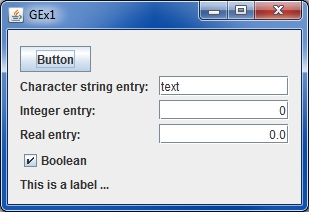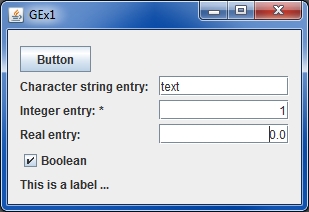Modified data : Différence entre versions
(Page créée avec « TBW ... Return to the introduction ↑ Go to the next page → ») |
|||
| (2 révisions intermédiaires par le même utilisateur non affichées) | |||
| Ligne 1 : | Ligne 1 : | ||
| − | + | Sometimes, a " <font color=#FF0000>*</font> " character appears just after a label of an entry data widget. In fact, it occurs when the data has been modified by user by comparison to a “saved” value. More precisely, this “saved” value corresponds: | |
| + | * either to the default value at the first display (the one used at the instantiation), | ||
| + | * or to the data loaded (resp. saved) when reading (resp. writing) a file => after reading (resp. writing) a file, the " <font color=#FF0000>*</font> " character disappears | ||
| + | |||
| + | When a unit is changed, as the data is not actually changed because the value stored in memory is <u>not changed</u> and no " <font color=#FF0000>*</font> " character appears. | ||
| + | |||
| + | Idem, if the user enter a “new” value which, in fact, corresponds to the "saved" value, the " <font color=#FF0000>*</font> " character will disappear : | ||
| + | |||
| + | For example, imagine that the initial value of an integer is 0. | ||
| + | |||
| + | |||
| + | [[File:ModifiedData1.jpg]] | ||
| + | |||
| + | |||
| + | Then, if the user will enter "1" as a new value => " <font color=#FF0000>*</font> " character appears | ||
| + | |||
| + | |||
| + | [[File:ModifiedData2.jpg]] | ||
| + | |||
| + | |||
| + | At last, if the same user will reenter "0", the " <font color=#FF0000>*</font> "character will disappear | ||
| + | |||
| + | |||
| + | [[File:ModifiedData1.jpg]] | ||
| + | |||
| + | |||
| + | It is possible to manage locally this mechanism using the following methods: | ||
| + | |||
| + | * <font color=#4169E1>setDisplayIsModifiedIndicator(DisplayIndicatorStatus)</font>, the status being « Automatic », « Always » or « Never » | ||
| + | * <font color=#4169E1>setSavedValue()</font> to change manually the saved value => if the saved value is the same as the current displayed one, the "*" character will disappear | ||
| + | |||
| + | === Management with read/write and copy/paste functions === | ||
| + | |||
| + | The "*" character could also appeared (or not) after reading or writing a configuration file (see [[GReadWrite_interface|GReadWrite interface and data files management]] topic). It is managed by using a flag set to true or false : | ||
| + | |||
| + | * when calling <font color=#4169E1>GFileManipulation.readConfig()</font> method, if the flag is set to false, an "*" will appear (of course, if the read value is different of the previous one) | ||
| + | * on the contrary, by using the <font color=#4169E1>GFileManipulation.writeConfig()</font> method, if the flag is set to true, the "*" will disappear after writing the configuration file (considering the reference configuration is then the one described in the file). | ||
| + | But of course, you may decide another way to run ... | ||
| + | |||
[[WELCOME_TO_THE_GENIUS_WIKI|Return to the introduction ↑]] | [[WELCOME_TO_THE_GENIUS_WIKI|Return to the introduction ↑]] | ||
[[Process_management|Go to the next page →]] | [[Process_management|Go to the next page →]] | ||
Version actuelle en date du 5 mai 2017 à 09:32
Sometimes, a " * " character appears just after a label of an entry data widget. In fact, it occurs when the data has been modified by user by comparison to a “saved” value. More precisely, this “saved” value corresponds:
- either to the default value at the first display (the one used at the instantiation),
- or to the data loaded (resp. saved) when reading (resp. writing) a file => after reading (resp. writing) a file, the " * " character disappears
When a unit is changed, as the data is not actually changed because the value stored in memory is not changed and no " * " character appears.
Idem, if the user enter a “new” value which, in fact, corresponds to the "saved" value, the " * " character will disappear :
For example, imagine that the initial value of an integer is 0.
Then, if the user will enter "1" as a new value => " * " character appears
At last, if the same user will reenter "0", the " * "character will disappear
It is possible to manage locally this mechanism using the following methods:
- setDisplayIsModifiedIndicator(DisplayIndicatorStatus), the status being « Automatic », « Always » or « Never »
- setSavedValue() to change manually the saved value => if the saved value is the same as the current displayed one, the "*" character will disappear
Management with read/write and copy/paste functions
The "*" character could also appeared (or not) after reading or writing a configuration file (see GReadWrite interface and data files management topic). It is managed by using a flag set to true or false :
- when calling GFileManipulation.readConfig() method, if the flag is set to false, an "*" will appear (of course, if the read value is different of the previous one)
- on the contrary, by using the GFileManipulation.writeConfig() method, if the flag is set to true, the "*" will disappear after writing the configuration file (considering the reference configuration is then the one described in the file).
But of course, you may decide another way to run ...

